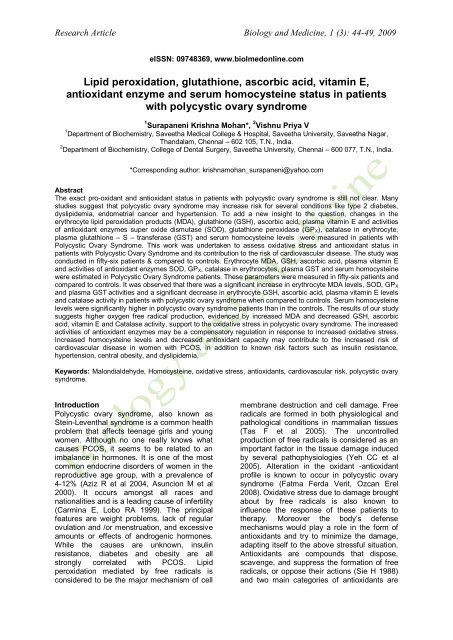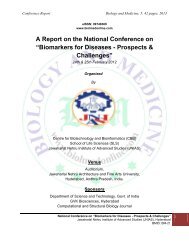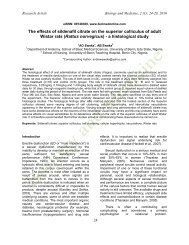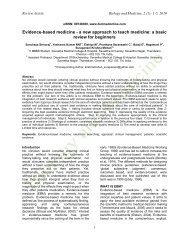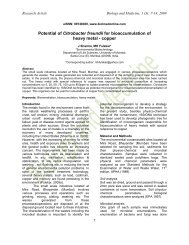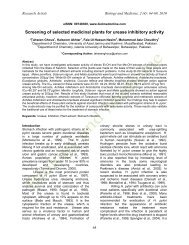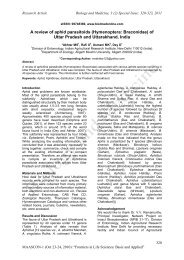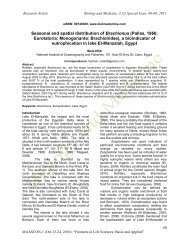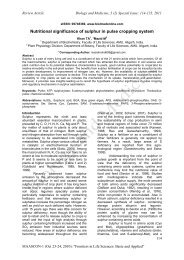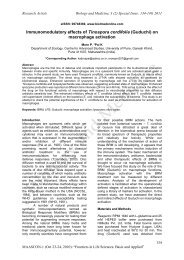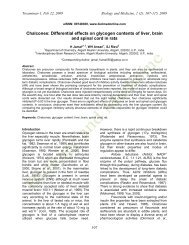Lipid peroxidation, glutathione, ascorbic acid, vitamin E
Lipid peroxidation, glutathione, ascorbic acid, vitamin E
Lipid peroxidation, glutathione, ascorbic acid, vitamin E
You also want an ePaper? Increase the reach of your titles
YUMPU automatically turns print PDFs into web optimized ePapers that Google loves.
Research Article Biology and Medicine, 1 (3): 44-49, 2009in polycystic ovary syndrome. Similar reportsof decreased GSH, Ascorbic <strong>acid</strong> and VitaminE levels in patients with polycystic ovarysyndrome have been reported by variousstudies (Dinger Y et al 2005).In our study the erythrocyteantioxidant enzymes i.e. SOD & GP x activitieshave been increased significantly in patientswith PCOS compared to controls. SOD is theimportant antioxidant enzyme having anantitoxic effect against super oxide anion. Theover expression of SOD might be an adaptiveresponse and it results in increaseddismutation of superoxide to hydrogenperoxide. GP X , an oxidative stress inducibleenzyme plays a significant role in the peroxylscavenging mechanism and in maintainingfunctional integration of the cell membranes(Chandra R et al 2000). The rise in the activityof GP X could be due to its induction to counterthe effect of increased oxidative stress.The Glutathione – S – Transferase isa group of multifunctional proteins, which playa central role in detoxification of electrophilicchemicals & the hepatic removal of potentiallyharmful hydrophobic compounds from blood(Smith GJ et al 1977). We have observed asignificant increase in the GST activity inpatients with polycystic ovary syndromecompared to controls. The rise in the activity ofGST could be due to its induction to counterthe effect against increased oxidative stress.In the present study, we haveobserved a significant decrease in the activityof catalase in patients with PCOS compared tocontrols. Catalase is the enzyme, whichprotects the cells from the accumulation ofhydrogen peroxide by dismutating it to formwater and oxygen or by using it as an oxidantin which it works as a peroxidase (Lenzi A et al1993).Homocysteine has been recognizedrecently as a risk factor for vascular diseases.In our study, Serum Homocysteine levels weresignificantly increased in patients with PCOSand compared to controls. An increased serumhomocysteine level is associated with theformation of atherosclerotic plaques andmyocardial infarction. The sulfhydryl groups inhomocysteine were oxidized to disulfidecatalyzed by the transition metals by whichseveral reactive oxygen species andhydroperoxides were produced and initiateslipid <strong>peroxidation</strong> which is responsible forendothelial injury. Similar reports of increasedlevels of homocysteine in polycystic ovarysyndrome were reported by Ahmed Badawy etal (Ahmed Badawy et al 2007). With multipleregression analysis the reduction inantioxidants along with significant increase inthe lipid <strong>peroxidation</strong>, antioxidant enzymesand homocysteine levels was calculated to beindependent from the BMI, Testosterone andFAI (Free Androgen Index) in patients withPoly Cystic Ovary Syndrome (PCOS)compared to Controls ( p > 0.05) and theseparameters were considered as theindependent determinants significantlyincreased oxidative stress and increasedHomocysteine levels in patients with PCOS.In conclusion, oxidative stress isincreased in patients with polycystic ovarysyndrome. The results of our study haveshown higher oxygen free radical production &decreased catalase activity, support tooxidative stress in PCOS. The increasedactivities of antioxidant enzymes may be acompensatory regulation in response toincreased oxidative stress. Increasedhomocysteine levels and decreasedantioxidant capacity may contribute to theincreased risk of cardiovascular disease inwomen with PCOS, in addition to known riskfactors such as insulin resistance,hypertension, central obesity, anddyslipidemia. So, the treatment withantioxidants in the initial stages of the diseasemay be useful as secondary therapy toprevent the oxidative damage.ReferencesAhmed Badawy, Omnia State, Soma Sh.Abd ElGawad and Omar Abd El Aziz (2007), “Plasmahomocysteine and polycystic ovary syndrome: themissed link”, European Journal of Obstetrics andGynaecology and Reproductive Biology, 131 (1), 68– 72.Asuncion M, Calvo RM, San Millan JL, et al(2000), “A prospective study of the prevalence ofthe polycystic ovary syndrome in unselectedCaucasian women from Spain”, Journal of ClinicalEndocrinology & Metabolism, 85(7), 2434 – 2438.Aziz R, Woods KS, Reyna R et al (2004), “Theprevalence and features of the polycystic ovarysyndrome in an unselected population”, Journal ofClinical Endocrinology & Metabolism, 89 (6), 2745– 2749.Baker H, Frank D, and Winley N C (1968). “ClinicalVitaminology”, pp.772.Beers, R.F. AND Sizer, I.W (1952), “Aspectrophotometric method for measuring thebreakdown of hydrogen peroxide by Catalase”,Journal of Biological Chemistry,195, pp.133-140.Beutler E, Duron O, and Kelly BM (1963),“Improved method for the determination of blood
Research Article Biology and Medicine, 1 (3): 44-49, 2009<strong>glutathione</strong>”, Journal of . Lab. Clinical Medicine, 61,pp.882-888.Carmina E, Lobo R A (1999), Do hyperandrogenicwomen with normal menses have polycystic ovarysyndrome? Fertility & Sterility 71: 319 – 322.Carmina E, Lobo RA (1999) Polycystic ovarysyndrome (PCOS):Arguably the most commonendocrinopathy is associated with significantmorbidity in women. Journal of ClinicalEndocrinology & Metabolism,84: 1897-1899.Chandra R, Aneja R, Rewal C, Konduri R, Dass K,and Agarwal S (2000), “An opium alkaloidpapaverineameliorates ethanol inducedhepatotoxicity: diminution of oxidative stress”, IndanJournal of Clinical Biochemistry, 15(2), pp.155-60.Cotgreave I, Moldeus P, Orrenius S (1988), “Hostbiochemical defense mechanisms againstprooxidants”, Annual Review of Pharmacology andToxicology, 28, pp.189-212.Dinger Y, Akcay T, Erdem T, Ilker Saygili E,Gundogdu S (2005), DNA damage, DNAsusceptibility to oxidation and <strong>glutathione</strong> level inwomen with polycystic ovary syndrome,Scandanavian Journal of LaboratoryInvestigations, 65 (8), 721 – 728.Dodge J F, Mitchell G, and Hanahan D J (1968),“The preparation and chemical characterization ofhemoglobin free ghosts of human red blood cells”,Archives of Biochemistry and Biophysics, 110,pp.119-130.E. Mor, P. Saadat, A. Bayrak, R. Z. Sokol, J. K.Jain, D. E. Tourgeman and R. J. Paulson (2003),“Insulin resistance in polycystic ovary syndrome:impact on ovulation and common clinical andmetabolic parameters”, Fertility and Sterility, 79,Supplement 2, Page 8.Fatma Ferda Verit, Ozcan Erel (2008), OxidativeStress in Nonobese Women with Polycystic OvarySyndrome: Correlations with Endocrine andScreening Parameters, Gynecology ObstetricsInvestigations, 65, 233-239.Jain, S.K., Mcvie, R., Duett, J. and Herbst, J.J(1989), “Erythrocyte membrane lipid <strong>peroxidation</strong>and glycosylated hemoglobin in diabetes”,Diabetes, 38, pp.1539-1542.Lenzi A, Cualosso F, Gandini L, Lombardo F andDondero F (1993), “Placebo controlled double-blindcross over trial <strong>glutathione</strong> therapy, in maleinfertility”, Human Reproduction, 9, pp.2044.Misra, HP and Fridovich, I (1972), “The role ofsuper oxide anion in the auto oxidation ofepinephrine and a simple assay for super oxidedismutase”, Journal of Biological Chemistry, 247,pp.3170-3175.Paglia, D.E. AND Valentine, W N (1967), “Studieson the quantitative and qualitative characterizationof erythrocyte <strong>glutathione</strong> peroxidase”, Journal ofLab. Clinical Medicine, 70, pp.158-159.Quist E H (1980), “Regulation of erythrocytemembrane shape by calcium ion”, Biochemistry andBiophysics Research Communication, 92, 631-637.Sie H (1988), “Oxidative stress: from basic researchto clinical application”, American Journal ofMedicine, 9, pp.31-38.Smith GJ, Ohl VS, Litwack G. Ligandin (1977),“The Glutathione – S – Transferases, andchemically induced hepato carcinogenesis”, Areview, Cancer Research, 37, pp.8-14.Susmeeta T. Sharma and John E. Nestler (2006),“Prevention of diabetes and cardiovascular diseasein women with PCOS: Treatment with insulinsensitizers”, Best Practice & Research ClinicalEndocrinology & Metabolism, Volume 20, Issue 2,Pages 245-260.Tas F, Hansel H, Belce A, Ilvan S, argon A, CamlicaH, Topuz E (2005), “Oxidative stress in ovariancancer”, Medical Oncology, 22(1), pp.11-15.The Rotterdam ESHRE/ASRM-sponsored PCOSconference workshop group 2004 revised 2003consensus on diagnostic criteria and long – termhealth risks related to polycystic ovary syndrome,Fertility & Sterility, 81, 19 – 25.Tietz, N W (1986). “In; Text book of clinicalchemistry, Edited by N W Tietz, W B Saunderscompany, Philadelphia, London, Toronto”, pp.960-962.Warholm, M., Guthenberg, C., Christer von Bahrand Mannervik, B (1985), “Glutathione transferasesfrom human liver. In: Methods of enzymology, AltonMelster (Ed.)”, Academic Press, Vol 113, pp. 500-501.Yeh CC, Hou MF, Tsai SM, Lin SK, Hsiao JK,Huang JC, Wang LH, Wu SH, Hou LA, Ma H, TsaiLY (2005), “Superoxide anion radical, lipidperoxides and antioxidant status in the blood ofpatients with ovarian cancer”, Clinica Chimica Acta,Nov, 381(1-2), pp.104 –11.Yildirim B, Demir S, Temur I, Erdemir R, Kaleli B(2007), “<strong>Lipid</strong> <strong>peroxidation</strong> in follicular fluid ofwomen with polycystic ovary syndrome”, Journal ofReproductive Medicine, 52 (8), 722 – 726.


